Processor design is a subfield of computer science and computer engineering (fabrication) that deals with creating a processor, a key component of computer hardware.
Distributed computing is a field of computer science that studies distributed systems, defined as computer systems whose inter-communicating components are located on different networked computers.
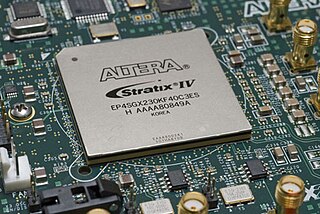
A field-programmable gate array (FPGA) is a type of configurable integrated circuit that can be repeatedly programmed after manufacturing. FPGAs are a subset of logic devices referred to as programmable logic devices (PLDs). They consist of an array of programmable logic blocks with a connecting grid, that can be configured "in the field" to interconnect with other logic blocks to perform various digital functions. FPGAs are often used in limited (low) quantity production of custom-made products, and in research and development, where the higher cost of individual FPGAs is not as important, and where creating and manufacturing a custom circuit wouldn't be feasible. Other applications for FPGAs include the telecommunications, automotive, aerospace, and industrial sectors, which benefit from their flexibility, high signal processing speed, and parallel processing abilities.
In software engineering, multitier architecture is a client–server architecture in which presentation, application processing and data management functions are physically separated. The most widespread use of multitier architecture is the three-tier architecture.
IA-64 is the instruction set architecture (ISA) of the discontinued Itanium family of 64-bit Intel microprocessors. The basic ISA specification originated at Hewlett-Packard (HP), and was subsequently implemented by Intel in collaboration with HP. The first Itanium processor, codenamed Merced, was released in 2001.
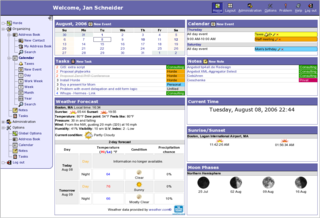
A web application is application software that is created with web technologies and runs via a web browser. Web applications emerged during the late 1990s and allowed for the server to dynamically build a response to the request, in contrast to static web pages.
In software engineering, service-oriented architecture (SOA) is an architectural style that focuses on discrete services instead of a monolithic design. SOA is a good choice for system integration. By consequence, it is also applied in the field of software design where services are provided to the other components by application components, through a communication protocol over a network. A service is a discrete unit of functionality that can be accessed remotely and acted upon and updated independently, such as retrieving a credit card statement online. SOA is also intended to be independent of vendors, products and technologies.
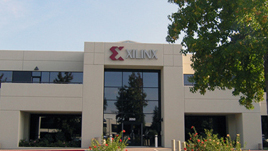
Xilinx, Inc. was an American technology and semiconductor company that primarily supplied programmable logic devices. The company is renowned for inventing the first commercially viable field-programmable gate array (FPGA). It also pioneered the first fabless manufacturing model.
REST is a software architectural style that was created to guide the design and development of the architecture for the World Wide Web. REST defines a set of constraints for how the architecture of a distributed, Internet-scale hypermedia system, such as the Web, should behave. The REST architectural style emphasises uniform interfaces, independent deployment of components, the scalability of interactions between them, and creating a layered architecture to promote caching to reduce user-perceived latency, enforce security, and encapsulate legacy systems.
A web framework (WF) or web application framework (WAF) is a software framework that is designed to support the development of web applications including web services, web resources, and web APIs. Web frameworks provide a standard way to build and deploy web applications on the World Wide Web. Web frameworks aim to automate the overhead associated with common activities performed in web development. For example, many web frameworks provide libraries for database access, templating frameworks, and session management, and they often promote code reuse. Although they often target development of dynamic web sites, they are also applicable to static websites.
A software factory is a structured collection of related software assets that aids in producing computer software applications or software components according to specific, externally defined end-user requirements through an assembly process. A software factory applies manufacturing techniques and principles to software development to mimic the benefits of traditional manufacturing. Software factories are generally involved with outsourced software creation.
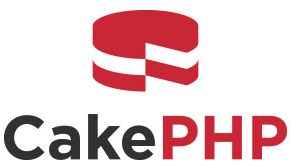
CakePHP is an open-source web framework. It follows the model–view–controller (MVC) approach and is written in PHP, modeled after the concepts of Ruby on Rails, and distributed under the MIT License.
Database-centric Architecture or data-centric architecture has several distinct meanings, generally relating to software architectures in which databases play a crucial role. Often this description is meant to contrast the design to an alternative approach. For example, the characterization of an architecture as "database-centric" may mean any combination of the following:
Domain-driven design (DDD) is a major software design approach, focusing on modeling software to match a domain according to input from that domain's experts. DDD is against the idea of having a single unified model; instead it divides a large system into bounded contexts, each of which have their own model.
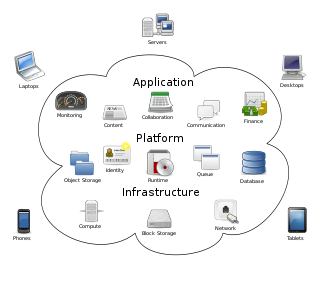
"Cloud computing is a paradigm for enabling network access to a scalable and elastic pool of shareable physical or virtual resources with self-service provisioning and administration on-demand," according to ISO.

The Institute for System Programming (ISP) of the Russian Academy of Sciences was founded on January 25, 1994, on the base of the departments of System Programming and Numerical Software of the Institute for Cybernetics Problems of the RAS. ISP RAS belongs to the Division of Mathematical Sciences of the RAS.
DevOps is a methodology integrating and automating the work of software development (Dev) and information technology operations (Ops). It serves as a means for improving and shortening the systems development life cycle. DevOps is complementary to agile software development; several DevOps aspects came from the agile approach.
In software engineering, a microservice architecture is an architectural pattern that organizes an application into a collection of loosely coupled, fine-grained services that communicate through lightweight protocols. This pattern is characterized by the ability to develop and deploy services independently, improving modularity, scalability, and adaptability. However, it introduces additional complexity, particularly in managing distributed systems and inter-service communication, making the initial implementation more challenging compared to a monolithic architecture.

AWS Lambda is an event-driven, serverless Function as a Service (FaaS) provided by Amazon as a part of Amazon Web Services. It is designed to enable developers to run code without provisioning or managing servers. It executes code in response to events and automatically manages the computing resources required by that code. It was introduced on November 13, 2014.
"Serverless computing is a cloud service category in which the customer can use different cloud capabilities types without the customer having to provision, deploy and manage either hardware or software resources, other than providing customer application code or providing customer data. Serverless computing represents a form of virtualized computing." according to ISO/IEC 22123-2 Function as a service and serverless database are two forms of serverless computing.







